 |
| 10/24/1924 Chicago Tribune snipping. |
1924 saw the local Klan expand with an active auxiliary women's group, an attempt at building a foreign born auxiliary order of the Red Robe, cross burnings, threats, kidnappings, as well as claimed election and policy victories. But it started out with a visit from the sitting governor of Illinois to the new local Klan headquarters for a political rally. Almost exactly two months after it had been very publicly dedicated by the Imperial Wizard Hiram Evans and Illinois Grand Dragon Charles G. Palmer. From the coverage in the St. Joseph Record on 1/25/1924:
There is a separate post on that event here, with the local Republican and Klan speakers, newspaper coverage, and later open Klan support for Small and his Republican faction in the 1924 elections.
The local Klan advertised open meetings throughout February for the public to learn more about the Klan and the "Royal Riders of the Red Robe" (an affiliated group for foreign born citizens dedicated to "100% Americanism"). From the 2/1/1924 Courier:
A public appearance by the women's auxiliary of the Ku Klux Klan was made at the Herald of Hope church, Plymouth Community Church and Dunkard Church locally according to the 2/4 and 2/10 Champaign News-Gazette, the 2/11 and 2/18/1924 Courier:
The Klan violence in Southern Illinois in the town of Herrin had finally escalated to the point that Klan raider S. Glenn Young had deposed the local leadership and law enforcement and was personally running the town with a Klan army. From the book, "Bloody Williamson" on Young's brief stint as "dictator" of Williamson:
The Sheriff of Williamson ended up at the Champaign County Jail. From the 2/11/1924 News-Gazette:
The military would eventually restore a perilous return to order and regular authorities in charge, but it would be another month before Young left the area for another Klan job, this time an official leadership role. More on that later when Young comes back to Champaign in May.
Area Klan events attracted Klan members from the Twin Cities and other small towns, including the custom of visiting pro-Klan churches. From the 3/18/2024 Courier describing recent visits (including a previous visit to the First Christian church) to Rantoul by area Klansmen:
April saw a number of cross burnings. The first were on campus, including one at the home of a University dean. From the 4/11/1924 Courier and Daily Illini:
Later in April there was a cross burning and threat against a recently elected local Black Republican precinct committeeman. The coverage in the courier highlights how the Black community was often differentiated between the "respectable element" and those deemed to be part of the race "problem" needing a solution. One can find parallels between modern terminology of the "good ones" versus various racial stereotypes and slurs. From the 4/21/1924 Courier:
The "color line" of Northern segregation during the Jim Crow era was more nuanced and lacked the overt signage and less direct legal codification. In Champaign-Urbana, this segregation was enforced with social norms, understandings, and extralegal enforcement by civilians and local police. A Courier article from 3/10/1920 explained how a local Black police Sheriff's deputy walked the edge of this color line in his duties:
Black newspapers circulated in the area would note safe businesses and venues for Black residents. They also included social events, Black organizational news, and other events within the Black community that the local white newspapers ignored. Below is an example of a taxi service available to Black customers from the 2/28/1920 Chicago Whip newspaper that circulated locally. This paper ran a regular local news update for area towns with significant Black Communities like the Twin Cities:
Fear of indiscriminate violence and retaliation (especially after the series of so-called "race riots," lynchings, and outright pogroms of this period) was very evident in Black newspapers circulating locally in these years. It should not be surprising that some of the enforcement of the color line and the Black community was directed by people within it. From the 5/28/1921 Whip (the Bethel AME Church was and still is one of the important African-American churches in Champaign-Urbana):
These conditions led to a complex relationship between the two segregated communities where someone deemed "undesirable" within the Black community could face harsh enforcement measures from both communities. It also led to sometimes strange overlap of overtly white supremacist textbooks and some Black community leaders to embrace similar concepts of what constituted the "respectable element." In the aftermath of the first Red Scare, pushing for racial equality could be seen as "radical" and communistic threat to American stability (more on that in future posts). Booker T. Washington's accommodationist arguments, for example, would often appear in both. From Elson's (a Northerner, it should be noted) openly white supremacist U. S. History textbook and the 7/3/1920 Chicago Whip:
One of the many items for sale at Breedlove's store was Booker T. Washington's infamous Atlanta exposition address (text). From the 1/22/1921 Whip:
In what became known as the "Atlanta compromise," booker assured white audiences that the current place of Black people was "at the bottom of life," endorsed social segregation, and argued against calls for equality. This was described as in exchange for equal economic opportunities that never materialized:
The wisest among my race understand that the agitation of questions of social equality is the extremest folly, and that progress in the enjoyment of all the privileges that will come to us must be the result of severe and constant struggle rather than of artificial forcing.
In May, some of the cases from previous bootlegging raids with the Klan were still working their way through the courts. Infamous Klan raider S. Glenn Young was in town and available for testimony in his role with the local case.. From the 5/12/1924 Courier:
Young's planned Klan lecture in Champaign would be a bit delayed, in part because of an assassination attempt and road ambush that wounded both he and his wife later this same May. From the 5/24/1924 Courier:
The Lincoln Young was driving was part of his payment from the Klan for his work for them doing raids in Williamson County. Young had left Williamson the month before to take a leadership position as a Klan "Kleagal" overseeing Klan operations in East St. Louis. The story of "Bloody Williamson" is far crazier than these moments in Champaign County could ever indicate. I highly recommend Paul M. Angle's book of the same name.
Klan related intimidation and violence was also happening on a smaller scale in Champaign-Urbana. Police would use the Klan presence to terrorize Black citizens. From the 5/24/1924 Courier:
Later a number of kidnappings would occur and be blamed on Klansman, though, as usual, disavowed officially by the local Klan leadership itself. From the 5/29 and 6/6/1924 Courier:
This second kidnapping article had another Klan news item from Indiana tucked next to it that noted the peculiar Klan and partisan politics of Midwestern states at the time.
Klan events were still occurring throughout Champaign County. One that got local headlines due to a double drowning near Homer:
July was a much busier month for public and official Klan events. The 7/2/1924 Courier reported a massive event on the first of the month, overwhelming the area around the Klan headquarters in downtown Urbana. It also noted that the local Klan would be going out of State for large Klan events for the 4th of July:
The 7/16/1924 News-Gazette also noted the local Klan was making its presence known at other regional events and winning prizes for their turnout:
A little later that July, there was a massive local Klan parade and march. From the 7/19 Courier and 7/20/1924 News-Gazette:
Klan raider Glenn Young would return to Champaign for a crowd of thousands. Like many of his events after the ambush, he brought his bullet riddled car with him to the show. He spent time with his friend and colleague from local raids in Champaign County, Sheriff John Gray at the Sheriff's office. From the 7/25/1924 Courier:
In this atmosphere, the Courier mocked locals who were concerned about potential violence when the Klan showed up to the local carnival, 80 marching in with a "drum and bugle corps." From the 8/9/1924:
A large Klan event in Danville included local Klan members. the 8/7 and 8/11/1924 Courier reported that the incoming crowds required a special train run for the extra traffic:
The local Klan would also do a "pilgrimage" to a Rantoul event with a familiar area Klan minister. From the 8/14/1924 News-Gazette:
August also saw another large public Klan funeral for William LaSell. From the 8/20/1924 News-Gazette:
The 8/23/1924 Courier reported that the Sheriff had interrupted a planned Klan flogging, arresting the Klan's would-be target for allegedly neglecting his children. Sheriff's deputies were guarding the targets home in light of the cross burning there earlier:
The end of August saw a massive "grand homecoming of the Ku Klux Klan at Crystal Lake park" with the Illinois Grand Dragon and notable Klan ministers. The women's and juniors auxiliary are mentioned in the advertisement listing the schedule of events. From the 8/29 Courier and the 8/31/1924 News-Gazette with brief coverage of the parade and fireworks:
Soon after another local delegation of Klan members attended a large Klan event in Decatur requiring the use of six train cars on the local "Illinois Traction System." On the way back into town, a small fight broke out with local American Legion members that made the news as well:
September saw an alleged copy-cat cross burning by a vengeful husband to terrify his estranged wife. From the 9/23/1924 Courier:
October would see more overt political activities by the Illinois Klans. The 10/12/1924 News-Gazette noted a massive caravan of automobiles and train coaches to a Springfield event with the Illinois Grand Dragon:
The 10/24/1924 Chicago Tribune would report that major Klan figures, from the Illinois Grand Dragon Charles G. Palmer to infamous Klan raider S. Glenn Young, were supporting the re-election of Republican Len Small and his slate of Republican candidates aligned with his faction within the party. Palmer would audaciously brag about the Klan's growing political influence:
Before the election, the local Klan tried to literally and figuratively put out some controversial fires by demanding an end to "unauthorized" cross burnings. The now very open local Exalted Cyclops of Champaign County's Zenith Klan No. 56 made it clear that there would be dire ramifications to those who did so:
A few days later the local Klan would have an open house meeting for the public. From the 11/4/1924 (election day) Courier:
The "unauthorized" cross-burning controversy appears to have quickly faded into the background as the local Klan joined celebrations across the North and Midwest as Klan and Klan backed candidates won elections across the country. Klan backed Republican gubernatorial candidates won in Illinois and Indiana, for example. Locally a number of local Klan members won offices, including some familiar faces from Governor Small's earlier 1924 visit to the local Klan headquarters. From the 11/5/1924 Daily Illini:
Just from this small sampling from the Daily Illini coverage are States Attorney Roy R. Cline (Klan member number 180), Circuit Clerk Boyd S. Blaine (Klan number 2227), and James A. Reeves (Klan number 2031). Not just Klan supported candidates, but outright dues paying Klan members.
The amount of gloating and bile from the Klan's Fiery Cross newspaper afterward was palpable. Needless to say, they immediately planned a celebratory rally for their victories throughout the Midwest, including in Illinois. From the 11/7/1924 Fiery Cross:
In December the Illinois Klan announced that it would be "probing" the "alien" students at the major universities of the State, including the local University of Illinois. From the 12/12/1924 Fiery Cross:
The local Klan also continued and expanded its Christmas tradition for the kids. From the 12/17 and 12/22 Courier as well as the 12/23/1924 News-Gazette:
The "Women of the Ku Klux Klan" contributed their own description of the 1924 Klan Christmas festivities to the 12/26/1924 Courier:
As usual, the newspaper and the Klan didn't ruin the mystery of who was playing Santa. Even if the mystery of the Exalted Cyclops was no longer a secret at all.
The next C-U Klan posts will focus on the decline, scandals, corruption, and murders that saw the second Klan fade out of the headlines, starting with the 1925 Murders, Convictions and Parades.1925 Murders, Convictions and Parades





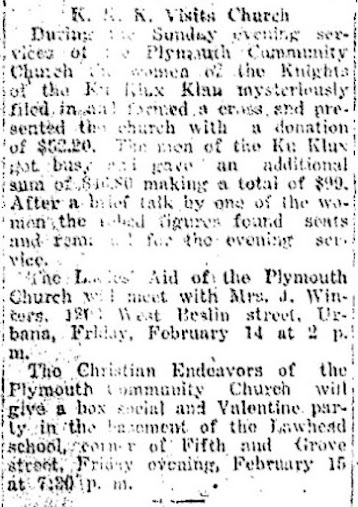





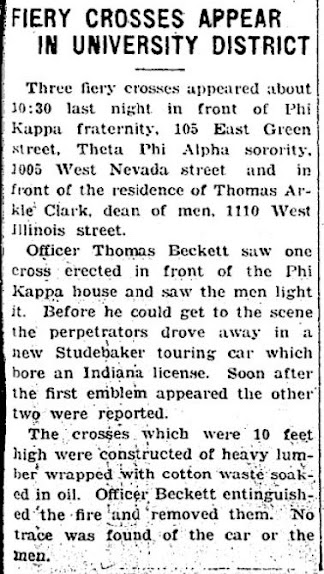











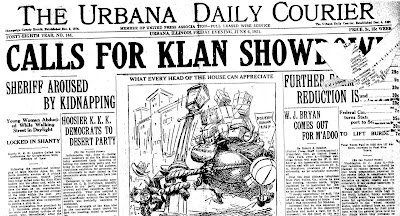























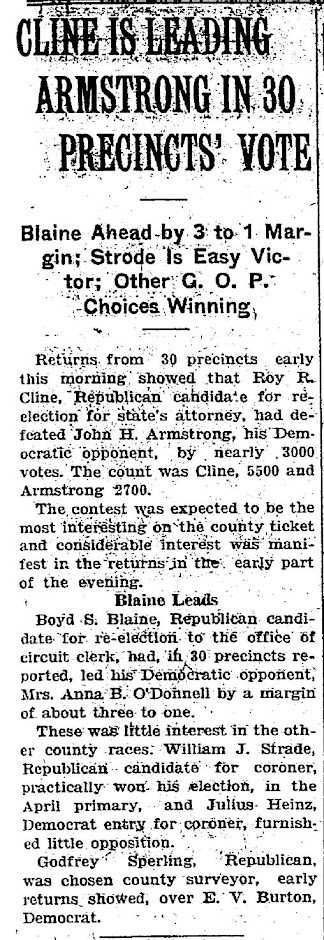





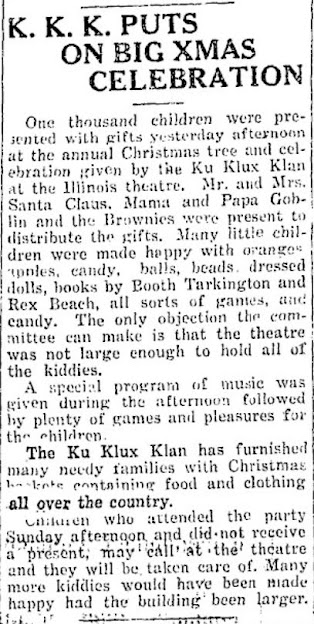


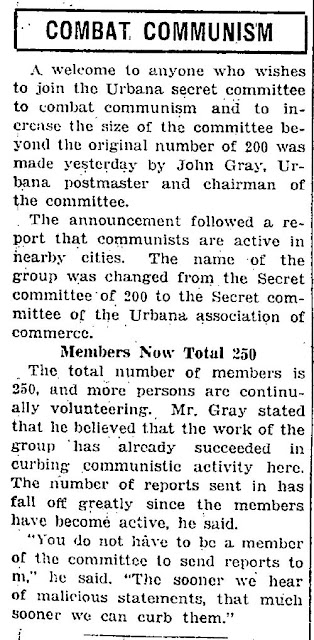



No comments:
Post a Comment